Estimation of Hydraulic Parameters from the Soil Water Characteristic Curve
Abstract
1. Introduction
2. Materials and Methods
3. Results
3.1. First Drainage—Sand
- First stage: +10 cm, Δt1 = (0–10) min = 10 min.
- Second stage: +6 cm, Δt2 = (10–28) min = 18 min.
- Third stage: −7 cm, Δt3 = (28–64) min = 36 min.
- Fourth stage: −12 cm, Δt4 = (64–84) min = 20 min.
- Fifth stage: −24 cm, Δt5 = (83–130) min = 47 min.
3.2. First Drainage—Sandy Loam
- First stage: +28 cm, Δt1 = (218–0) min = 218 min.
- Second stage: −9 cm, Δt2 = (436–218) min = 218 min.
- Third stage: −40 cm, Δt3 = (654–436) min = 218 min.
3.3. Second Wetting—Sand
- First stage: −12 cm, Δt1 = (0–31) min = 31 min.
- Second stage: +5 cm, Δt2 = (31–51) min = 20 min.
- Third stage: +10 cm, Δt3 = (51–68) min = 17 min.
- Fourth stage: +13 cm, Δt4 = (68–100) min = 32 min.
3.4. Second Wetting—Sandy Loam
- First stage: −14 cm, Δt1 = (124–0) min = 124 min.
- Second stage: + 20 cm, Δt2 = (342–124) min = 218 min.
- Third stage: + 58 cm, Δt3 = (488–342) min = 146 min.
3.5. Second Drainage—Sand
- First stage: +6 cm, Δt1 = (21–0) min = 21 min.
- Second stage: 0 cm, Δt2 = (51–21) min = 30 min.
- Third stage: −8 cm, Δt3 = (78–51) min = 27 min.
- Fourth stage: −12.5 cm, Δt4 = (92–78) min = 14 min.
- Fifth stage: −20 cm, Δt5 = (123–92) min = 31 min.
- Sixth stage: −25 cm, Δt6 = (138–123) min = 15 min.
3.6. Second Drainage—Sandy Loam
- First stage: + 23 cm, Δt1 = (128–0) min = 128 min.
- Second stage: −10 cm, Δt2 = (408–128) min = 280 min.
- Third stage: −40 cm, Δt3 = (626–408) min = 218 m
4. Discussion
5. Conclusions
Author Contributions
Funding
Institutional Review Board Statement
Informed Consent Statement
Data Availability Statement
Conflicts of Interest
References
- Ren, X.; Kang, J.; Ren, J.; Chen, X.; Zhang, M. A method for estimating soil water characteristic curve with limited experimental data. Geoderma 2020, 360, 114013. [Google Scholar] [CrossRef]
- Chai, J.; Khaimook, P. Prediction of soil-water characteristic curves using basic soil properties. Transp. Geotech. 2020, 22, 100295. [Google Scholar] [CrossRef]
- Fredlund, D.G.; Sheng, D.; Zhao, J. Estimation of soil suction from the soil-water characteristic curve. Can. Geotech. J. 2011, 86, 338–344. [Google Scholar] [CrossRef]
- Brooks, A.T.; Corey, A.T. Hydraulic Properties of Porous Media; Hydrology Papers; Colorado State University: Fort Collins, CO, USA, 1964. [Google Scholar]
- Gaudet, J.P. Transferts d’eau et de soluté dans les sols non-saturés: Mesures et simulation. Ph.D. Thesis, Universite Scientifique et Médicale de Grenoble, Grenoble, France, 1978; p. 350. [Google Scholar]
- van Genuchten, R. Calculating the unsaturated hydraulic conductivity with a new closed form analytical model. Water Res. Prog. Res. Rep. 1978, 78, 8–63. [Google Scholar]
- van Genuchten, R. A closed form equation for predicting the hydraulic conductivity of unsaturated soils. Soil Sci. Soc. Am. J. 1980, 44, 862–898. [Google Scholar] [CrossRef]
- Mualem, Y. A new model for predicting the hydraulic conductivity of unsaturated porous media. Water Resour. Res. 1976, 12, 513–522. [Google Scholar] [CrossRef]
- Havercamp, R. Résolution de L’équation de l’Infiltration de l’Eau dans le Sol: Approches Analytiques et Numériques. 1983. Available online: https://theses.hal.science/tel-00688101 (accessed on 20 March 2023).
- Angelaki, A.; Sakellariou-Makrantonaki, M.; Tzimopoulos, C. Laboratory experiments and estimation of cumulative infiltration and sorptivity. Water Air Soil Pollut. Focus 2004, 4, 241–251. [Google Scholar] [CrossRef]
- Sakellariou-Makrantonaki, M.; Angelaki, A.; Evangelides, C.; Bota, V.; Tsianou, E.; Floros, N. Experimental determination of Hydraulic Conductivity at unsaturated soil column. Procedia Eng. 2016, 162, 83–90. [Google Scholar] [CrossRef]
- Eyo, E.U.; Ng’ambi, S.; Abbey, S.J. An overview of soil–water characteristic curves of stabilised soils and their influential factors. J. King Saud Univ.-Eng. Sci. 2022, 34, 31–45. [Google Scholar] [CrossRef]
- Li, X.; Hu, C.; Li, F.; Gao, H. Determining soil water characteristic curve of lime treated loess using multiscale structure fractal characteristic. Sci. Rep. 2020, 10, 21569. [Google Scholar] [CrossRef]
- Ket, P.; Oeurng, C.; Degré, A. Estimating Soil Water Retention Curve by Inverse Modelling from Combination of In Situ Dynamic Soil Water Content and Soil Potential Data. Soil Syst. 2018, 2, 55. [Google Scholar] [CrossRef]
- Sihag, P.; Angelaki, A.; Chaplot, B. Estimation of the recharging rate of ground water using Random Forest Technique. Appl. Water Sci. 2020, 10, 1–11. [Google Scholar] [CrossRef]
- Kumar, S.; Sekhar, M.; Reddy, D.V.; Mohan Kumar, M.S. Estimation of Soil Hydraulic Properties and Their Uncer-tainty: Comparison between Laboratory and Field Experiment. Hydrol. Process. 2010, 24, 3426–3435. [Google Scholar] [CrossRef]
- Suzaki, A.; Minato, S.; Ghose, R. SEG Technical Program Expanded Abstracts; Society of Exploration Geophysicists: Houston, TX, USA, 2019; pp. 2798–2802. [Google Scholar]
- Jiang, C.; Zhang, H.; Wang, X.; Feng, Y.; Labzovskii, L. Challenging the land degradation in China’s Loess Plateau: Benefits, limitations, sustainability, and adaptive strategies of soil and water conservation. Ecol. Eng. 2019, 127, 135–150. [Google Scholar] [CrossRef]
- Xu, X.; Jian, W.; Wu, N.; Xu, X. Experimental study on the SWCC transition zone features of unsaturated soil. Indian Geotech. J. 2019, 50, 348–358. [Google Scholar] [CrossRef]
- Rao, S.M.; Rekapalli, M. Identifying the dominant mode of moisture transport during drying of unsaturated soils. Sci. Rep. 2020, 10, 4322. [Google Scholar] [CrossRef]
- Fuentes, C.; Zavala, M.; Saucedo, H. Relationship between the storage coefficient and the soil-water retention curve in subsurface agricultural drainage systems: Water table drawdown. J. Irrig. Drain. Eng. 2009, 135, 279–285. [Google Scholar] [CrossRef]
- Patil, N.; Rajput, G. Evaluation of water retention functions and computer program “Rosetta” in predicting soil water characteristics of seasonally impounded shrink-swell soils. J. Irrig. Drain. Eng. 2009, 135, 286–294. [Google Scholar] [CrossRef]
- Angelaki, A.; Sakellariou-Makrantonaki, M.; Tzimopoulos, C. Theoretical and Experimental Research of Cumulative Infiltration. Transp. Porous Media 2013, 100, 247–257. [Google Scholar] [CrossRef]
- Zhai, Q.; Rahardjo, H.; Quanti, F. Cation of Uncertainties in Soil—Water Characteristic Curve Associated with Fitting Parameters. Eng. Geol. 2013, 163, 144–152. [Google Scholar] [CrossRef]
- Zhai, Q.; Rahardjo, H.; Satyanaga, A.; Dai, G.; Zhuang, Y. Framework to estimate the soil-water characteristic curve for soils with different void ratios. Bull. Eng. Geol. Environ. 2020, 79, 4399–4409. [Google Scholar] [CrossRef]
- Liang, X.; Liakos, V.; Wendroth, O.; Vellidis, G. Scheduling irrigation using an approach based on the van Genuchten model. Agric. Water Manag. 2016, 176, 170–179. [Google Scholar] [CrossRef]
- Abdallah, A. Prediction of the Soil Water Retention Curve from Basic Geotechnical Parameters by Machine Learning Techniques. In Information Technology in Geo-Engineering, Proceedings of the 3rd International Conference (ICITG), Guimarães, Portugal, 29 September–2 October 2019; Springer International Publishing: Berlin/Heidelberg, Germany, 2020; pp. 382–392. [Google Scholar]
- Amanabadi, S.; Vazirinia, M.; Vereecken, H.; Vakilian, K.A.; Mohammadi, M.H. Comparative Study of Statistical, Numerical and Machine Learning-based Pedotransfer Functions of Water Retention Curve with Particle Size Distribution Data. Eurasian Soil Sci. 2019, 52, 1555–1571. [Google Scholar] [CrossRef]
- Lamorski, K.; Šimůnek, J.; Sławiński, C.; Lamorska, J. An estimation of the main wetting branch of the soil water retention curve based on its main drying branch using the machine learning method. Water Resour. Res. 2017, 53, 1539–1552. [Google Scholar] [CrossRef]
- Achieng, K.O. Modelling of soil moisture retention curve using machine learning techniques: Artificial and deep neural networks vs support vector regression models. Comput. Geosci. 2019, 133, 104320. [Google Scholar]
- Yaseen, Z.; Sihag, P.; Yusuf, B.; Al-Janabi, A. Modelling infiltration rates in permeable stormwater channels using soft computing techniques. Irrig. Drain. 2021, 70, 117–130. [Google Scholar] [CrossRef]
- Batsilas, I.; Angelaki, A.; Chalkidis, I. Hydrodynamics of the Vadose Zone of a Layered Soil Column. Water 2023, 15, 221. [Google Scholar] [CrossRef]
- Wang, S.; Fan, W.; Zhu, Y.; Zhang, J. The effects of fitting parameters in best fit equations in determination of soil-water characteristic curve and estimation of hydraulic conductivity function. Rhizosphere 2021, 17, 100291. [Google Scholar] [CrossRef]
- Jabro, J.D.; Stevens, W.B. Soil-water characteristic curves and their estimated hydraulic parameters in no-tilled and conventionally tilled soils. Soil Tillage Res. 2022, 219, 105342. [Google Scholar] [CrossRef]
- Jabro, J.D.; Stevens, W.B.; Iversen, W.M.; Allen, B.L.; Sainju, U.M. Irrigation scheduling based on wireless sensors output and soil-water characteristic curve in two soils. Sensors 2020, 20, 1336. [Google Scholar] [CrossRef]
- Ghanbarian, B.; Skaggs, T.H. Soil water retention curve inflection point: Insight into soil structure from percolation theory. Soil Sci. Soc. Am. J. 2022, 86, 338–344. [Google Scholar] [CrossRef]
- Ranaivomanana, H.; Das, G.; Razakamanantsoa, A. Modeling of Hysteretic Behavior of Soil–Water Retention Curves Using an Original Pore Network Model. Transp. Porous Media 2022, 142, 559–584. [Google Scholar] [CrossRef]
- Zhang, F.; Zhao, C.; Lourenço, S.D.; Dong, S.; Jiang, Y. Factors affecting the soil–water retention curve of Chinese loess. Bull. Eng. Geol. Environ. 2021, 80, 717–729. [Google Scholar] [CrossRef]
- Nikooee, E.; Mirghafari, R.; Habibagahi, G.; Khorassani, A.G.; Nouri, A.M. Determination of soil-water retention curve: An artificial intelligence-based approach. In E3S Web of Conferences; EDP Sciences: Les Ulis, France, 2020; Volume 195, p. 02010. [Google Scholar]
- Yang, S.; Zheng, P.Q.; Yu, Y.T.; Zhang, J. Probabilistic analysis of soil-water characteristic curve based on machine learning algorithms. In IOP Conference Series: Earth and Environmental Science; IOP Publishing: Bristol, UK, 2021; Volume 861, p. 062030. [Google Scholar]
- Baumann, P.; Lee, J.; Behrens, T.; Biswas, A.; Six, J.; McLachlan, G.; Viscarra Rossel, R.A. Modelling soil water retention and water-holding capacity with visible–near-infrared spectra and machine learning. Eur. J. Soil Sci. 2022, 73, e13220. [Google Scholar] [CrossRef]
- Li, Y.; Vanapalli, S.K. Prediction of soil-water characteristic curves using two artificial intelligence (AI) models and AI aid design method for sands. Can. Geotech. J. 2022, 59, 129–143. [Google Scholar] [CrossRef]
- Vizitiu, O.P.; Calciu, I.; Pănoiu, I.; Simota, C. Soil physical quality as quantified by S index and hydro-physical indicies of some soils from Arges hydrographic basin Research. Res. J. Agric. Sci. 2011, 43, 249–256. [Google Scholar]
- Nolet, C.; Poortinga, A.; Roosje, P.; Bartholomeus, H.; Ruessink, G. Measuring and Modeling the Effect of Surface Moisture on the Spectral Reflectanceof Coastal Beach Sand. PLoS ONE 2014, 9, e112151. [Google Scholar] [CrossRef]
- Dexter, A.R.; Bird, N.R.A. Methods for predicting the optimum and the range of soil water contents for tillage based on the water retention curve. Soil Tillage Res. 2001, 57, 203–212. [Google Scholar] [CrossRef]
- Dexter, A.R. Soil physical quality: Part I. Theory, effects of soil texture, density and organic matter, and ef-fects on root growth. Geoderma 2004, 120, 201–214. [Google Scholar] [CrossRef]
- Richards, L.A. Capillary conduction of liquids through porous medium. Physics 1931, 1, 318–333. [Google Scholar] [CrossRef]
- Angelaki, A.; Sihag, P.; Sakellariou-Makrantonaki, M.; Tzimopoulos, C. The effect of sorptivity on cumulative Infiltration. Water Sci. Technol. Water Supply 2021, 21, 606–614. [Google Scholar] [CrossRef]
- Fullhart, A.T.; Kelleners, T.J.; Chandler, D.G.; McNamara, J.P.; Seyfried, M.S. Water Flow Modeling with Dry Bulk Density Optimization to Determine Hydraulic Properties in Mountain Soils. Soil Sci. Soc. Am. J. 2018, 82, 31–44. [Google Scholar] [CrossRef]
- Capparelli, G.; Spolverino, G. An Empirical Approach for Modeling Hysteresis Behavior of Pyroclastic Soils. Hydrology 2020, 7, 14. [Google Scholar] [CrossRef]
- Tao, G.L.; Zhang, J.R.; Zhuang, S.X.; Yang, L. Influence of compression deformation on the soil-water charac-teristic curve and its simplified representation method. J. Hydraul. Eng. 2014, 45, 1239–1246. [Google Scholar]
- Tao, G.; Li, Z.; Liu, L.; Chen, Y.; Gu, K. Effects of Contact Angle on the Hysteresis Effect of Soil-Water Characteristic Curves during Dry-Wet Cycles. Adv. Civ. Eng. 2021, 2021, 6683859. [Google Scholar] [CrossRef]
- Marković, M.; Filipović, V.; Legović, T.; Josipović, M.; Tadić, V. Evaluation of different soil water potential by field capacity threshold in combination with a triggered irrigation module. Soil Water Res. 2015, 10, 164–171. [Google Scholar] [CrossRef]
- Rai, R.K.; Vijay P, S.; Upadhyay, A. Soil Analysis, Planning and Evaluation of Irrigation Projects; Academic Press: Cambridge, MA, USA, 2017; Chapter 17; pp. 505–523. [Google Scholar]
- Lemos-Paião, A.P.; Lopes, S.; de Pinho, M. Analytical Study for Different Extremal State Solutions of an Irrigation Optimal Control Problem with Field Capacity Modes. Int. J. Appl. Comput. Math 2022, 8, 67. [Google Scholar] [CrossRef]
- Hohenegger, C.; Stevens, B. The role of the permanent wilting point in controlling the spatial distribution of precipitation. Proc. Natl. Acad. Sci. USA 2018, 115, 5692–5697. [Google Scholar] [CrossRef]
- Kang, S.; Shi, W.; Zhang, J. An improved water-use efficiency for maize grown under regulated deficit irrigation. Field Crops Res. 2000, 67, 207–214. [Google Scholar] [CrossRef]
- Lo, T.H.; Heeren, D.M.; Mateos, L.; Luck, J.D.; Martin, D.L.; Miller, K.A.; Barker, J.B.; Shaver, T.M. Field Characterization of Field Capacity and Root Zone Available Water Capacity for Varia-ble Rate Irrigation. Appl. Eng. Agric. 2017, 33, 559–572. [Google Scholar] [CrossRef]
- Evett, S.R.; Stone, K.C.; Schwartz, R.C.; O’Shaughnessy, S.A.; Colaizzi, P.D.; Anderson, S.K.; Anderson, D.J. Resolving discrepancies between laboratory-determined field capacity values and field water content observations: Implications for irrigation management. Irrig. Sci. 2019, 37, 751–759. [Google Scholar] [CrossRef]
- Sutton, B.G.; Merit, N. Maintenance of lettuce root zone at field capacity gives best yields with drip irrigation. Sci. Hortic. 1993, 56, 1–11. [Google Scholar] [CrossRef]
- Cong, Z.T.; Lü, H.F.; Ni, G.H. A simplified dynamic method for field capacity estimation and its parameter analysis. Water Sci. Eng. 2014, 7, 351–362. [Google Scholar]
- de Jong van Lier, Q.; Wendroth, O. Reexamination of the Field Capacity Concept in a Brazilian Oxisol. Soil Sci. Soc. Am. J. 2016, 80, 264–274. [Google Scholar] [CrossRef]
- Gómez-Armayones, C.; Kvalbein, A.; Aamlid, T.S.; Knox, J.W. Assessing evidence on the agronomic and environmental impacts of turfgrass irrigation management. J. Agron. Crop Sci. 2018, 204, 333–346. [Google Scholar] [CrossRef]
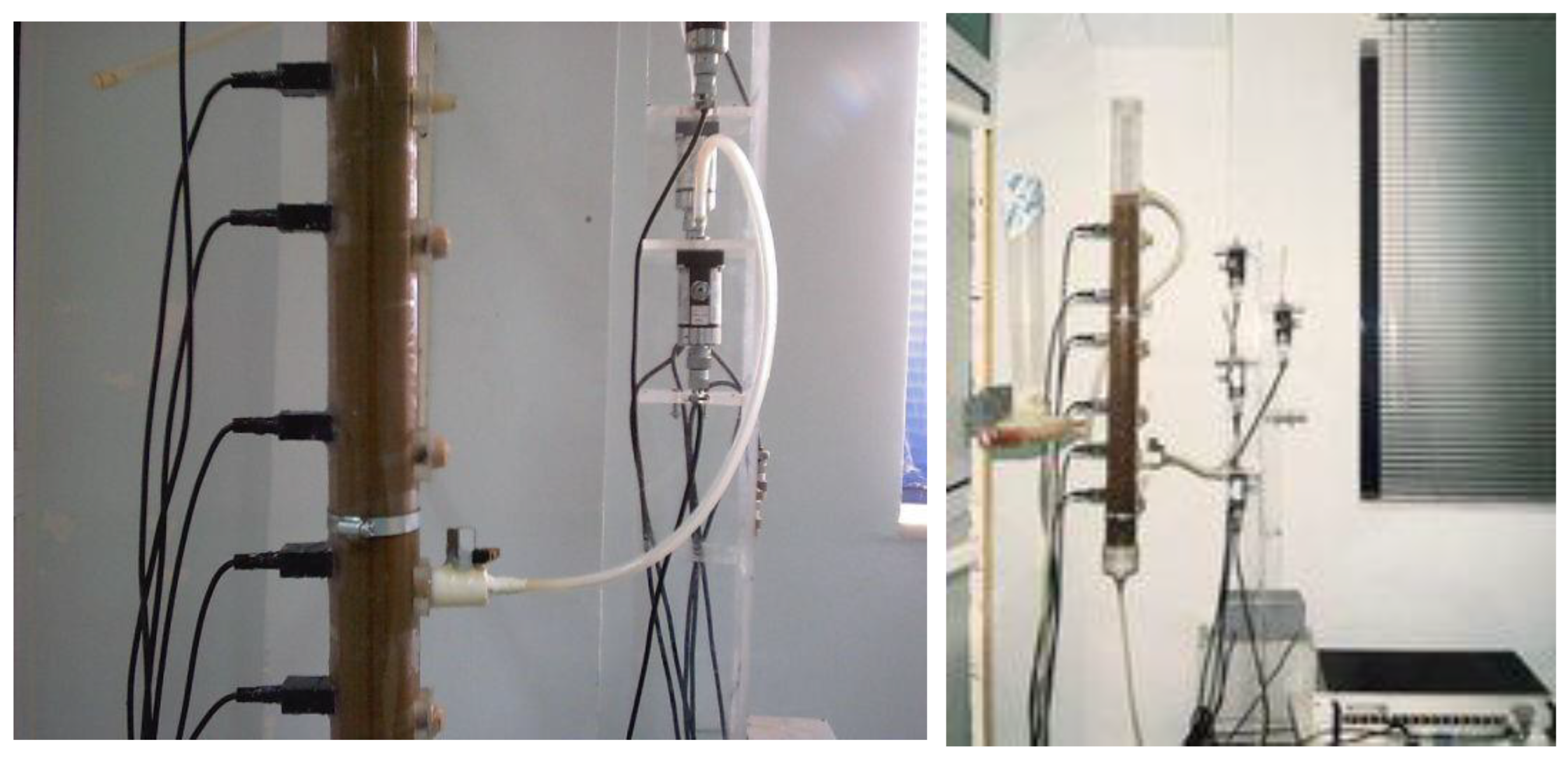
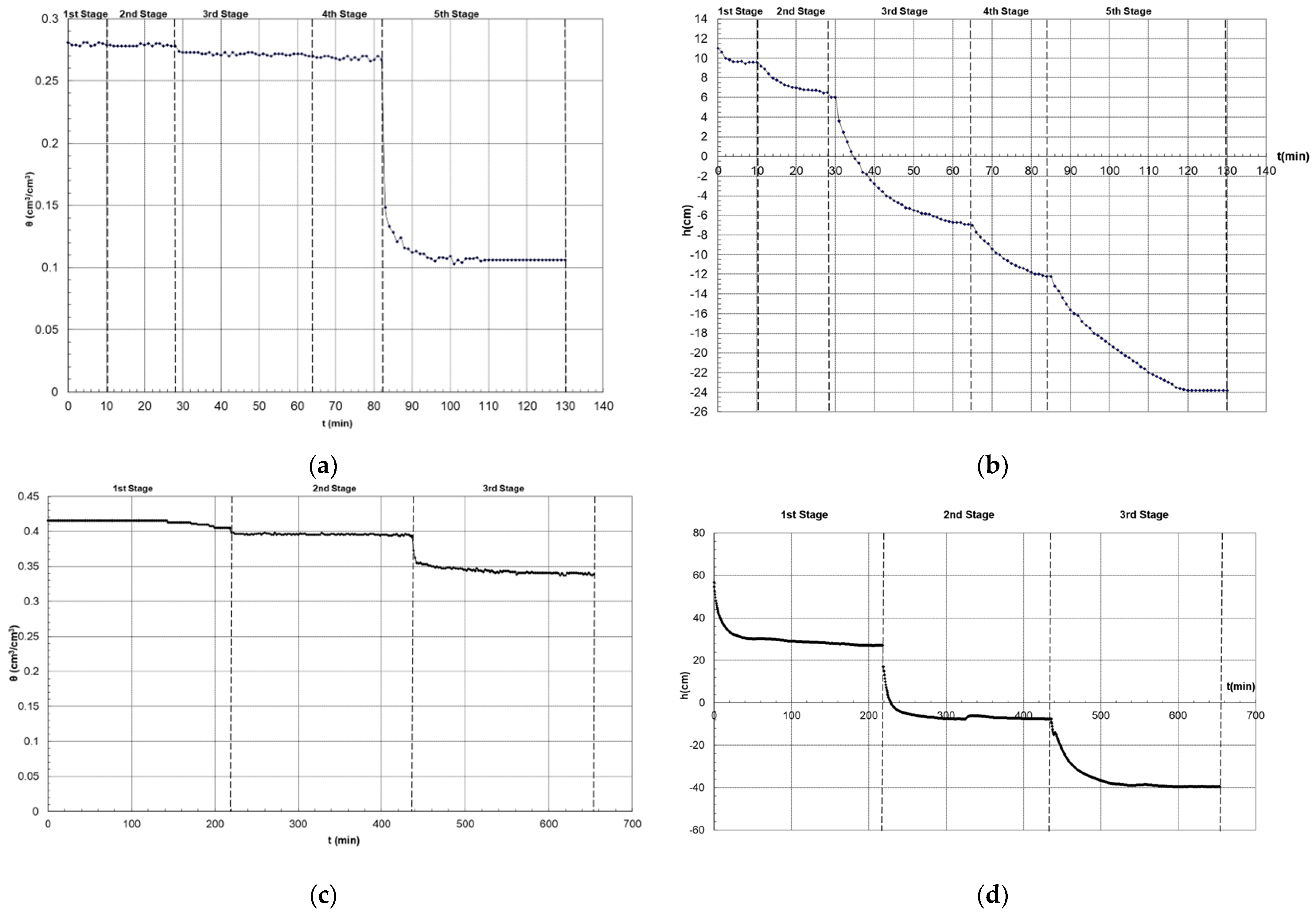
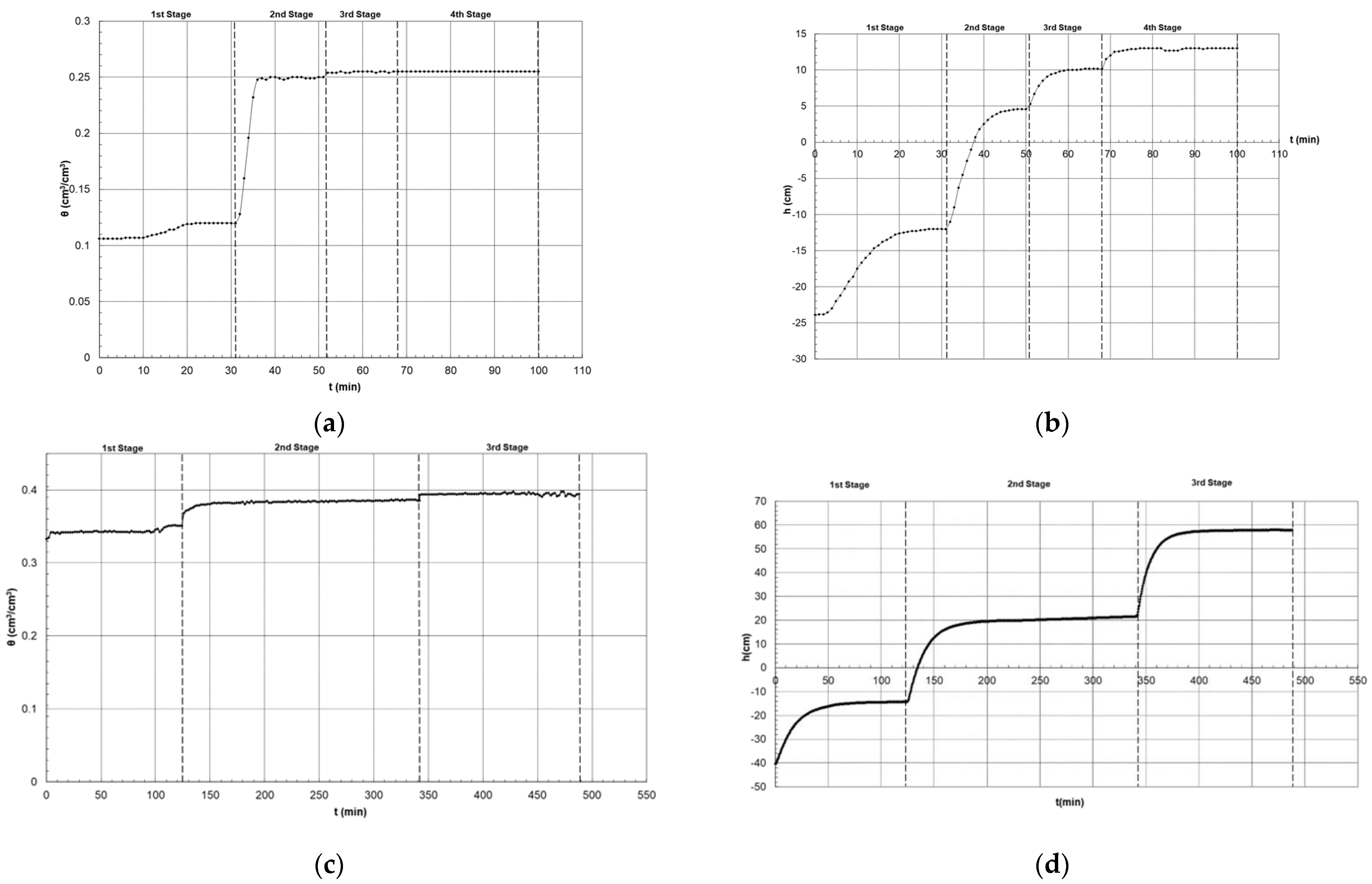
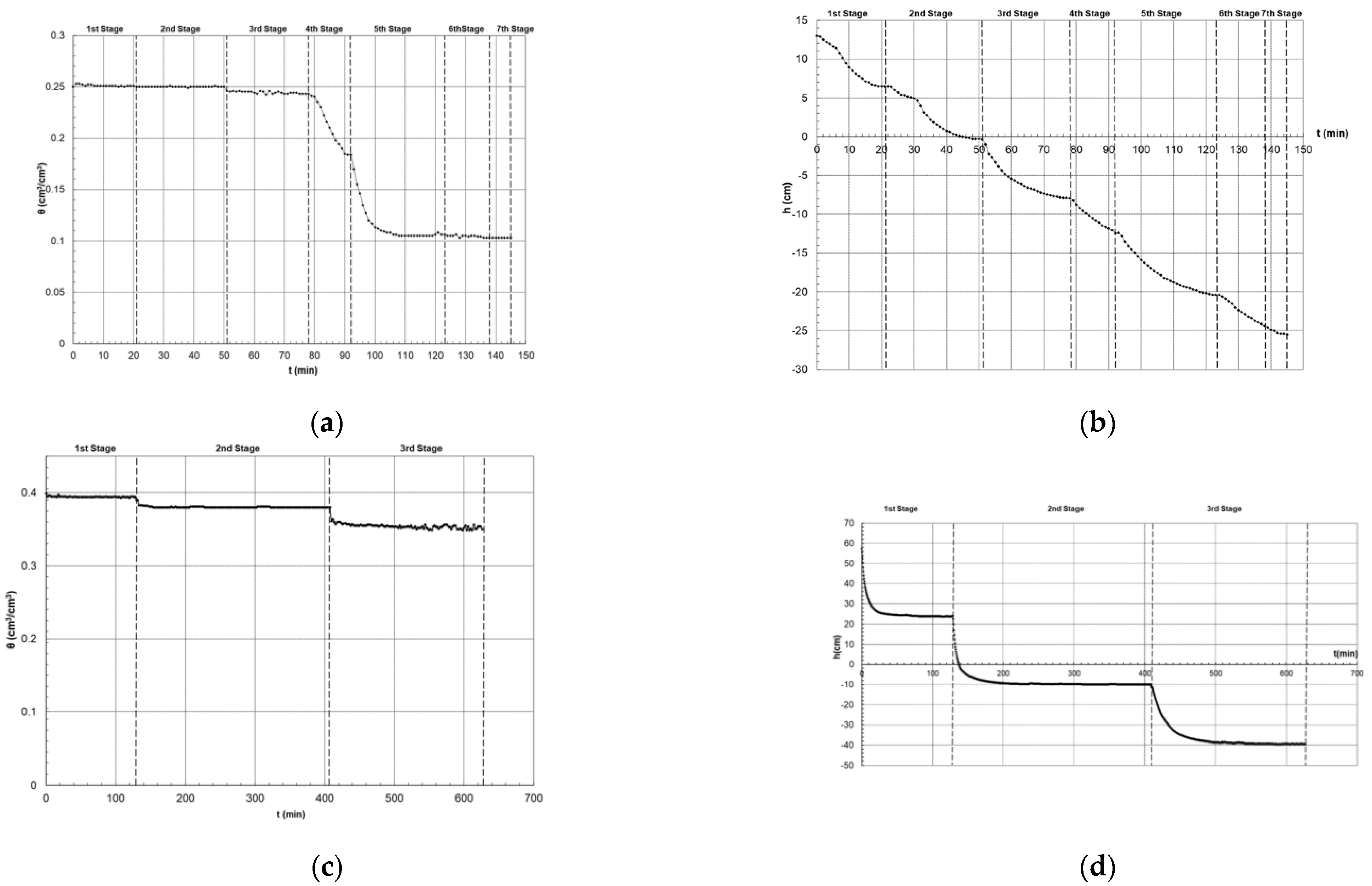
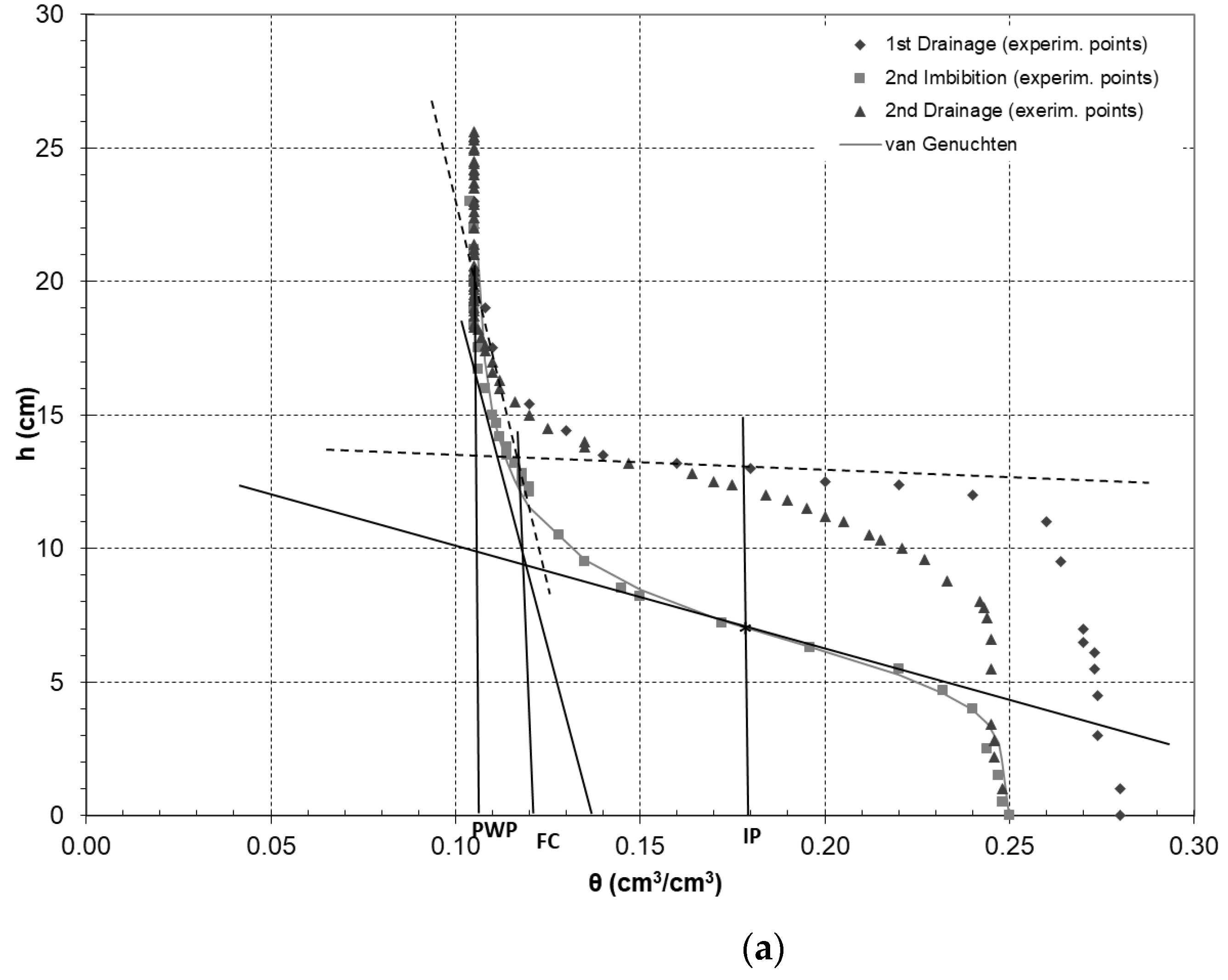
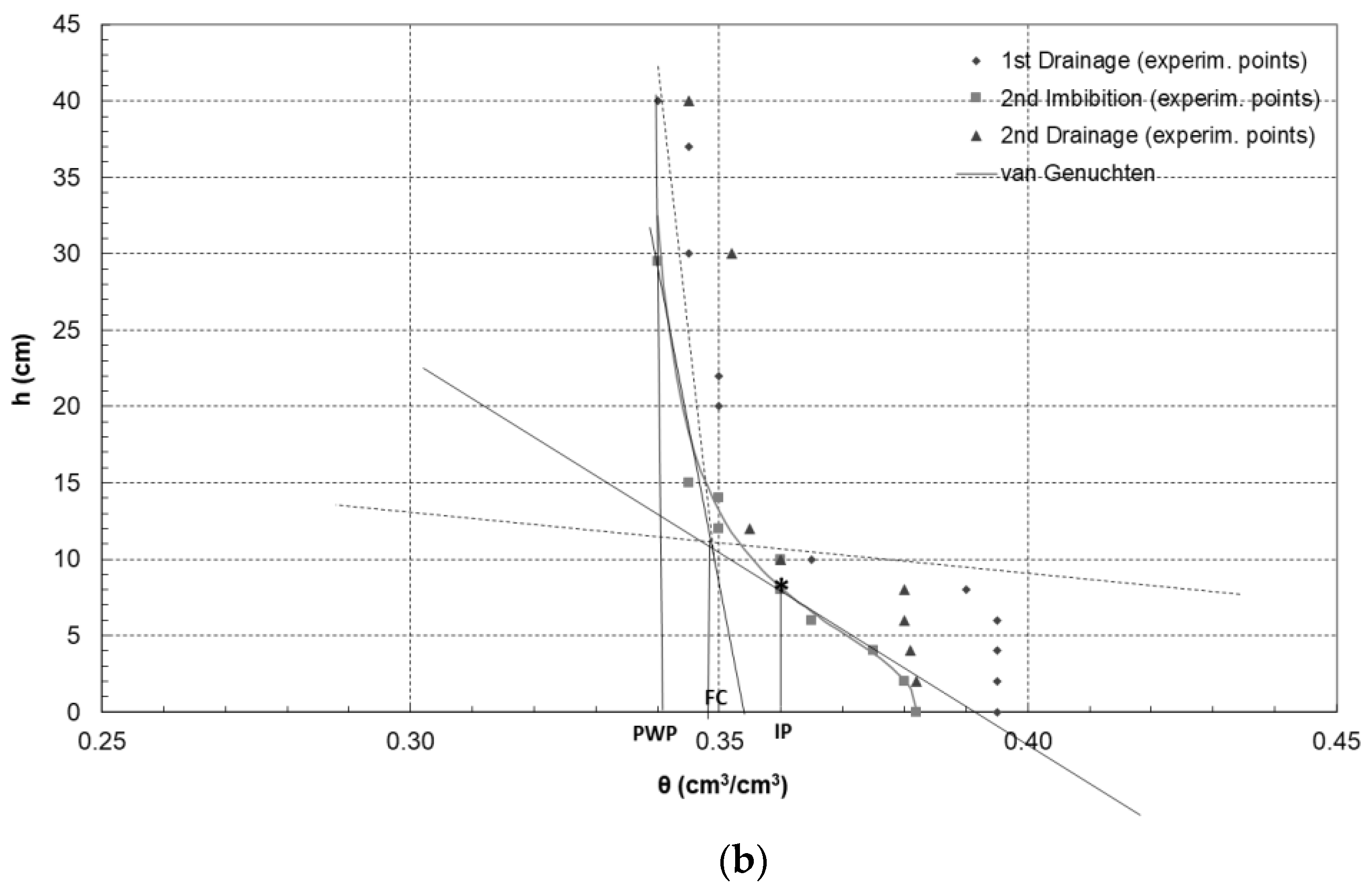
| Soil Sample | θi (cm3/cm3) | θs (cm3/cm3) | ρb (g/cm3) | |
|---|---|---|---|---|
| 1 | Sand | 0.002 | 0.295 | 1.56 |
| 2 | Sandy loam | 0.002 | 0.410 | 1.48 |
| Soil Sample | PWP (cm3/cm3) Measured (M) | PWP (cm3/cm3) Estimated (E) | Relative Mse (M-E) | FC (cm3/cm3) Measured (M) | FC (cm3/cm3) Estimated (E) | Relative Mse (M-E) | S | θIP (cm3/cm3) |
|---|---|---|---|---|---|---|---|---|
| Sand | 0.060 | 0.106 | 0.588 | 0.125 | 0.121 | 0.001 | −0.164 | 0.180 |
| Sandy loam | 0.210 | 0.340 | 0.383 | 0.350 | 0.348 | 0.000 | −0.023 | 0.361 |
Disclaimer/Publisher’s Note: The statements, opinions and data contained in all publications are solely those of the individual author(s) and contributor(s) and not of MDPI and/or the editor(s). MDPI and/or the editor(s) disclaim responsibility for any injury to people or property resulting from any ideas, methods, instructions or products referred to in the content. |
© 2023 by the authors. Licensee MDPI, Basel, Switzerland. This article is an open access article distributed under the terms and conditions of the Creative Commons Attribution (CC BY) license (https://creativecommons.org/licenses/by/4.0/).
Share and Cite
Angelaki, A.; Bota, V.; Chalkidis, I. Estimation of Hydraulic Parameters from the Soil Water Characteristic Curve. Sustainability 2023, 15, 6714. https://doi.org/10.3390/su15086714
Angelaki A, Bota V, Chalkidis I. Estimation of Hydraulic Parameters from the Soil Water Characteristic Curve. Sustainability. 2023; 15(8):6714. https://doi.org/10.3390/su15086714
Chicago/Turabian StyleAngelaki, Anastasia, Vasiliki Bota, and Iraklis Chalkidis. 2023. "Estimation of Hydraulic Parameters from the Soil Water Characteristic Curve" Sustainability 15, no. 8: 6714. https://doi.org/10.3390/su15086714
APA StyleAngelaki, A., Bota, V., & Chalkidis, I. (2023). Estimation of Hydraulic Parameters from the Soil Water Characteristic Curve. Sustainability, 15(8), 6714. https://doi.org/10.3390/su15086714






